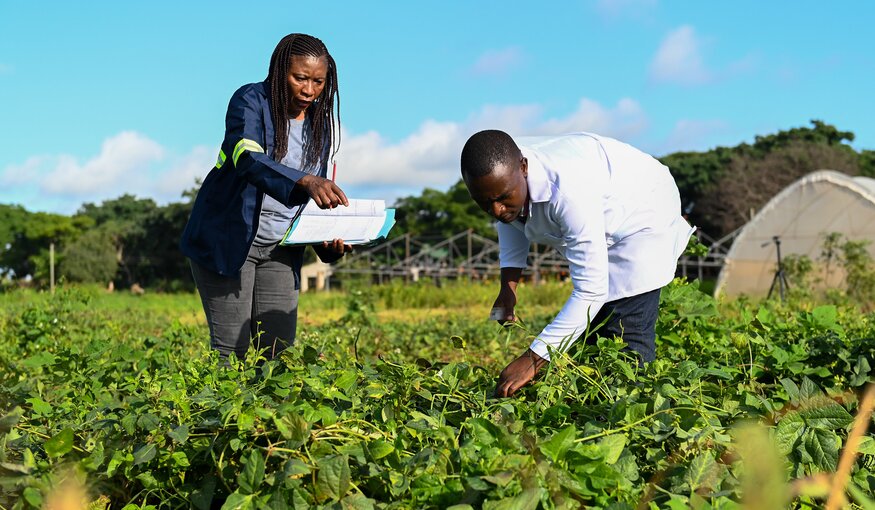African Genebanks Show the Way to the Future of Food Security

Staff at the National Plant Genetic Resources Centre (NPGRC) of the Zambia Agriculture Research Institute (ZARI) checking cowpea growing. Picture by Neil Palmer for the Crop Trust.
12 December 2023
Success is often said to be a journey, not a destination. If so, it might be useful to remember that travelers need to be aware of opportunities, and take them while they still exist.
At the COP28 climate summit in Dubai, world leaders focused on a global stocktake designed to assess countries’ success in meeting the goals of the Paris Agreement and to chart a better course forward for climate action.
Unfortunately, this gargantuan task will not be done overnight. Success will be measured not by a “silver bullet” but by our ability to mitigate and adapt to harsh realities over the long term.
Just as humanity has a narrowing time window to address the climate crisis, there are shrinking opportunities to make our food systems viable on a warming planet. This means we need to conserve crop genetic diversity, which enables us to breed crops that can withstand drought, flooding, heat, disease and pestilence. And we need to do this now, urgently—before diversity disappears forever. Every variety of every crop we lose is an opportunity we lose to adapt to climate change.
One of the best ways to protect this genetic lifeline is through genebanks, which preserve and make available seeds that farmers and breeders can use to produce improved crop varieties in the long term, even decades after they were collected and put into conservation.
This is why the Crop Trust has partnered with five African genebanks through Seeds for Resilience, a five-year project providing financial and technical support to safeguard the national crop diversity collections of Ethiopia, Ghana, Kenya, Nigeria and Zambia.
As the project enters its fifth year, it is timely to take stock of its noteworthy achievements and the challenges that remain.
Living Seeds
Genebanks are to seeds a bit what libraries are to books. But seeds, unlike books, are only useful if they are kept alive. As the acting director of Ghana’s national genebank, Daniel Kotey, noted during a GLF Live event this fall, genebanks are little more than mortuaries if the seeds are not managed properly.
Seeds for Resilience, which is supported by the German government through the German Development Bank (KfW), helps ensure precious seeds do not die in the hands of genebanks.
With only a fifth of African nations spending at least 10 percent of their budgets on food and agriculture—a goal set in the Maputo Declaration—the Seeds for Resilience project helps fill a financial and technical void. It strengthens genebank equipment and infrastructure; empowers genebank staff with technical knowledge to conduct the regular operations of a genebank; it upgrades their processes to align them with international standards; it enables genebanks to characterize the genetic diversity they manage so farmers can more easily select the diversity that will make them more resilient to climate change; and promotes the use of crop diversity among farmers.
Svalbard Milestone
The project also helps ensure that national genebanks are protected from unforeseen circumstances by storing copies of their seeds in the Svalbard Global Seed Vault, the ultimate conservation facility that insures against the many “what if?” scenarios threatening seed collections, including war, natural disasters and financial hardship.
Two months ago, Ghana made its first deposit when the Plant Genetic Resources Research Institute of the Council for Scientific and Industrial Research (CSIR-PGRRI)—a partner in the Seeds for Resilience project—contributed samples of maize, rice, eggplant and cowpea varieties. It became the 100th depositor to Svalbard as a result.
Kenya, Nigeria and Zambia also dispatched seeds for the October opening, marking further progress for the Seeds for Resilience project and adding to the existing backup collections of those genebanks in the Vault, which incidentally celebrated its 15th birthday this year.
Connecting With Farmers
In addition, Seeds for Resilience provides a full service to its African genebanks by giving them the tools to connect with farmers Farmers are not always aware of the value that genebanks offer to counter climate change and the narrowing of genetic diversity of crops.
The project has been filling this knowledge gap by strengthening links to users through “germplasm engagement groups,” a participatory approach that helps farmers to evaluate and select the crop varieties that best meet their needs. In Kenya, for example, Seeds for Resilience introduced farmers to diverse sorghum varieties with shorter growth cycles to minimize exposure to drought periods.
By sharing genetic diversity with farmers, Seeds for Resilience can also help overcome the challenge of malnutrition among smallholder farmers—who produce most of the continent’s food—while reducing food imports.
Seeds for Resilience is scheduled to end in 2025, but its achievements will endure in the enhanced resilience of African genebanks, which are increasingly addressing the continent’s food-related challenges through the conservation and sharing of crop diversity. It is essential that governments build on this progress by promoting diversification, which will allow for more resilient food systems that can mitigate unforeseen threats. The success of such efforts depends on taking opportunities now—before it is too late.
Seeds for Resilience is a five-year project to support the national genebanks of Ethiopia, Ghana, Kenya, Nigeria and Zambia funded by the German government through the German development bank, KfW.
Category: Seeds for Resilience


